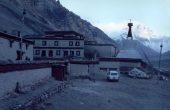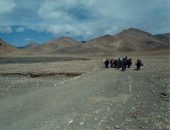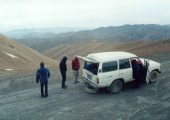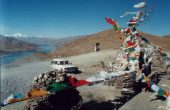Ripley attacks Tibet and Mount Everest
Ripley returns with his next installment from peaks on the top of the world. This time circling, like a three-legged mountain goat in the Himalayas, around Chomolungma, Goddess Mother of the Earth.
We were standing there scratching our heads again. The road was so bad that we were starting to wonder if we were even on a road. It was cold, we were tired and this difficult and colourless land was starting to get everyone down. But now here was an encouraging sign which read “You are 4 367 kilometres from Beijing”.
It wasn’t the “You are 3 kilometres from a nice hot shower” that we really wanted, but then China was never going to be that easy. In their Autonomous (read Repressed) Region of Tibet you are constantly reminded of how far you are from big, bad Beijing and very rarely of how far away anything useful is. But at least the sign told us this was indeed the road and also that we had driven exactly 35 kilometres in the three hours since seeing the sign saying “You are 4 332 kilometres from Beijing”.
That’s good going on the Friendship Highway. This is the road the Chinese built across the Himalayas to link two of Asia’s most mysterious cities, Lhasa and Kathmandu. The idea was to forge cordial links with their traditionally hostile southern neighbours in the wake of their 1959 invasion of Tibet… but it didn’t really work, the neighbours still hate the Chinese. The fact that it is the highest road in the world is relegated almost to a sideshow by the bizarre cultural divide spanned by the highway’s 920 kilometres. It is a divide with a drab and achromatic world at one end and a veritable kaleidoscope at the other, while sitting uncomfortably in the middle are a people whose famous colour is being slowly bleached into oblivion.
The Friendship experience really begins down in China proper – in Chengdu, Sechuan – because that is where travellers must first go to buy the compulsory ‘tour’ of Tibet.
At the customs desk in Chengdu Airport I found myself standing in front of one of the most beautiful women I have ever seen. She wore a gunmetal grey mini-skirt and matching jacket with lieutenants’ stripes and, unusually for her profession, welcomed me to her country with a heavenly smile. “Eeeengrish?” She was fascinated by my guidebook and began flicking through the pages as if they had been written by someone from another planet. Without warning, a rasping cough emanated from somewhere deep in her larynx and she fired a huge wad of phlegm under the counter. “Rrrrelcome in Chinaaa”.
She should have said “Rrrrelcome in New Chinaaa”. The recent construction history of Chengdu is a duplicate of every contemporary Chinese city; thousands of years of buildings, gardens, trees and culture have been steamrollered to make way for hideous skyscapers. In the middle of Chengdu’s concrete jungle stands the whopping Bank of China, a gigantic temple to the twin elements of Chinese building, green-tinted glass and formica. Every now and again you stumble down an alley and discover an ancient street they forgot to flatten and get a glimpse of how things used to be; smoky bookshops, blue-jacketed Party members sitting around in domino clubs and apothecaries run by Fu-Man-Chus with jars of weird and wonderful potions.
The day I arrived the Party had organised a parade of exotic-looking birds in the streets in an attempt to persuade the locals that birds should be admired, not eaten. It’s true, the Chinese will eat anything (a result of Mao’s Great Leap Forward which starved 60 million Chinese to death). Put your head around any kitchen door and you will see cats, dogs, hamsters, terrapins and snakes in cages ready for the pot. An American scientist at Chengdu’s famous Giant Panda Reserve told me she had once been asked by a visiting Beijing official during a tour of the facility “What do pandas taste like?”
Waiting for my Tibetan tour application to be processed, I went for a ride on a Chinese train to try and find something that wasn’t covered in formica. I headed for the buffet car for a Tsingtao beer and to look out of the window. It was one of those double-latched windows that needed a certain amount of leverage so I stood up on the seat to open it. For this, I got a clip round the ear. The fearsome woman in charge of the buffet car could hardly contain her anger. For a while she grudgingly left me in peace to look out at the rice paddies terracing their way up the hills and the peasants tilling away in the fields. But then her anger got the better of her and she found she could no longer have such a contemptible person in her carriage and I was sent back to my compartment in disgrace.
For the most populous place on earth, China can be a lonely place. No one, but no one, speaks English, no one ever smiles and the people seem genuinely disinterested in foreigners. Unlike on Indian trains, where being the only white person guarantees you a procession of people wanting to shake your hand, being the only gweilo here was more like having a dart-board tattooed on my forehead.
The ‘tour’ finally got underway (with five non-English speaking Japanese) and I flew, with a sigh of relief, in a rickety old Tupolev up to the enormous plateau that is Chinese Tibet. But where most cities have a welcome sign, Lhasa’s main drag is draped with an enormous military banner saying “Be a civilised citizen and build a civilised city.”
My heart sank again. The city has not escaped the tyranny of the green-tinted glass either but, so far at least, the eastern side of Lhasa remains as the Tibetans built it 1,500 years ago.
The Potala, the Dalai Lama’s old winter palace, stands supreme over the Land of the Snows, with its towering whitewashed walls and golden roof, the burgundy and saffron-robed monks rush up with welcoming smiles and then go off to prostrate themselves in prayer on dusty street corners. At the Jokhang, the holiest temple in the Buddhist world, I found myself in a human tide of pilgrims walking clockwise around the building, some banging drums, others spinning prayer wheels. In a fairly telling moment, a Chinese kid ran up with a plastic machine gun and sprayed us all with gunfire.
I finally found some Aussies to speak to and offloaded six days of banter on them over a couple of Tsingtaos… until we remembered that at 12,000 feet it’s not long before you fall off your bar stool. They had rented a Landcruiser, with driver, to take the high road to Kathmandu and had one spare place.
There is some debate about which is the world’s highest road. According to World Highways, the highest point on a road is the 15,814 feet Khunjerab Pass on Pakistan’s Karakoram Highway (the Friendship’s highest point, La Lungla Pass, is 487ft lower) but the Friendship Highway is higher for more of its length, traversing mostly the 12,000ft Tibetan plateau – so they rate it, overall, the highest road.
But there’s no debate about the Himalayan massif just to the south that blocks Tibet’s rainfall so effectively that the landscape is almost completely devoid of greenery. Glacial meltwater flows turquoise through the valleys but at this height plants find no purchase in the sea of freeze-shattered rock. Winter is the windy season and clouds of dust swirl around and up your nose, but to Tibetans, wind is their lifeblood. From every mountain and hilltop, every bridge and temple flutter thousands of prayer flags, arranged in different colours to represent the five elements – red (fire), green (wood), yellow (earth), blue (water) and white (iron) – and they believe that as the flags flutter they release their prayers into the wind.
By the time we got to a village-at-the-end-of-time called Tingri it had been seven days since anyone had seen a shower. Tingri lands a dilemma in your lap… a 67km ‘detour’ to Mount Everest. It’s the highest mountain in the world, so you take it, but the landslides and floods that had reduced the road to a goat track made us wish we hadn’t bothered. After an eternity you get to the Rhongpu Monastery at Everest base camp where 100 monks and 10 nuns practise their religion in a detached world where you feel every one of the 4 367 kilometres you are from Beijing.
We never saw Mount Everest from base camp because it was permanently covered in cloud, but a few days later we got to stand on La Lungla Pass looking out across a view which included four of the world’s 14 eight-thousand metre peaks. Miraculously, the clouds had temporarily parted from the peaks of Everest, Lhotse, Cho Oyo and Makalu. Deep breath needed.
From there it is down, down, down to the extraordinary town of Zhangmu on the Chinese border with Nepal which clings to about 15 hairpin bends in the highway as it plunges down a gorge to the Friendship Bridge. We got one final glare from the Chinese soldiers, just for good measure, as we crossed the bridge and left China and our Landcruiser behind.
We walked into what seemed like a parallel universe after four weeks in the People’s Republic; suddenly there was colour everywhere, women in bright saris, children bedecked in jewellery, loud music blared from shops, men were holding hands and water fell down the verdant sides of the gorge in spectacular falls.
The Aussies and I stood on the far side of the bridge giving each other high fives.
We got into a bus with “I love you friend” and “Feel good brother” written down the side, and the interior was plastered with Nepalese beauty queens. The seats were all occupied so they let us ride on the roof where a Nepalese saddhu was playing his flute. At every stop, the locals jumped off and bought beer and fruit and turned the roof of the bus into a drunken riot. The bus took us down through the Himalayan foothills, now covered in rhododendrons, magnolias and orchids and the sky was full of the birdsong of cuckoos.
It turned out that we had arrived in Nepal on the holiest weekend of the year, a water festival called Happy Holi. All the way to Kathmandu gangs of kids ran up to the bus and threw dozens of water bombs filled with red dye at us screaming “Happy, Happy Holi”. One particularly audacious kid clambered onto the roof and gave us all a dot of purple dye between our eyes. By the time we got to our guest house in Kathmandu’s ‘freak centre’ of Thamel we had been hit by approximately 1,000 water bombs.
Covered from head to foot in dye, we were relieved to see that the hotel receptionist had also been hit in the face by a red bomb. “A room… with a mattress; a shower… with water; and some food that wasn’t once someone’s pet …please!”





2 Comments
Join the discussion and tell us your opinion.
Thx for sharing the photos in such a good resolution.
Do you have any of the “feel good brother” bus?
Hi Antonio, I will ask Ripley if he has anything like that….Jo